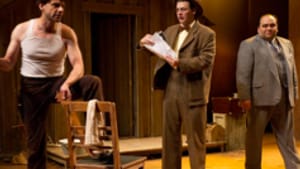Stay in the Loop
BSR publishes on a weekly schedule, with an email newsletter every Wednesday and Thursday morning. There’s no paywall, and subscribing is always free.
Ties that bind
Bruce Graham's "Mr. Hart and Mr. Brown' at People's Light

Portraits of people who casually use violence to attain their goals have been a staple of movies and TV, from the Godfather films to "The Sopranos." Philadelphia playwright Bruce Graham tackles the subject in Mr. Hart and Mr. Brown, currently receiving its world premiere at People's Light.
The play (based loosely on actual people) is set in a tiny Nebraska town in the 1920s, and deals with a meeting between two mysterious men. Richard ("Two-Gun") Hart, a transplanted Brooklynite, is the only lawman within 300 miles. Hart is a local hero, known for staunchly upholding the law and showing no mercy to outlaws.
One day, a man drives into town in a huge Deusenberg, dressed expensively and carrying fine food and wine. He identifies himself as Al Brown, an antiques dealer from Baltimore.
Alarming discovery
Ambrose Healey, enthusiastic cub reporter on the local newspaper, is eager to write about Brown and does some digging. Brown, it turns out, is a famous gangster— specifically, as we learn later, Al Capone. Even more alarming to Healey is his discovery of a close secret connection between Hart and Brown.
The two men prove to be similar in nature as well. Although they're on opposite sides of the law, both are willing to use violence to attain what they perceive as worthy ends: Hart kills to rid the world of scum, and Brown spreads his ill-gotten gains among a wide range of worthy causes.
The script deftly explores the shattering of Healey's youthful illusions about stark contrasts between heroes and villains. After his encounters with Hart and Brown, Healey's world will forever be tinged in shades of gray.
Body language
Pete Pryor's spare production uses a simple sepia set to suggest the stark Plains landscape. He keeps external stage business to a minimum and focuses on the relationships among the three main characters.
As Hart, Christopher Patrick Mullen has a constantly stiff bearing, body language that suggests a man with good reason to keep the world at bay. Richard Ruiz is entertainingly flamboyant as the alternately charming and treacherous Brown.
Michael Doherty vigorously conveys Healey's passion and recklessness. And Peter DeLaurier is effective as the elderly Healey of the 1960s, explaining to an unseen young person of another generation how he made the transition from idealism to cynical acceptance.♦
To read a response, click here.
The play (based loosely on actual people) is set in a tiny Nebraska town in the 1920s, and deals with a meeting between two mysterious men. Richard ("Two-Gun") Hart, a transplanted Brooklynite, is the only lawman within 300 miles. Hart is a local hero, known for staunchly upholding the law and showing no mercy to outlaws.
One day, a man drives into town in a huge Deusenberg, dressed expensively and carrying fine food and wine. He identifies himself as Al Brown, an antiques dealer from Baltimore.
Alarming discovery
Ambrose Healey, enthusiastic cub reporter on the local newspaper, is eager to write about Brown and does some digging. Brown, it turns out, is a famous gangster— specifically, as we learn later, Al Capone. Even more alarming to Healey is his discovery of a close secret connection between Hart and Brown.
The two men prove to be similar in nature as well. Although they're on opposite sides of the law, both are willing to use violence to attain what they perceive as worthy ends: Hart kills to rid the world of scum, and Brown spreads his ill-gotten gains among a wide range of worthy causes.
The script deftly explores the shattering of Healey's youthful illusions about stark contrasts between heroes and villains. After his encounters with Hart and Brown, Healey's world will forever be tinged in shades of gray.
Body language
Pete Pryor's spare production uses a simple sepia set to suggest the stark Plains landscape. He keeps external stage business to a minimum and focuses on the relationships among the three main characters.
As Hart, Christopher Patrick Mullen has a constantly stiff bearing, body language that suggests a man with good reason to keep the world at bay. Richard Ruiz is entertainingly flamboyant as the alternately charming and treacherous Brown.
Michael Doherty vigorously conveys Healey's passion and recklessness. And Peter DeLaurier is effective as the elderly Healey of the 1960s, explaining to an unseen young person of another generation how he made the transition from idealism to cynical acceptance.♦
To read a response, click here.
What, When, Where
Mr. Hart and Mr. Brown. By Bruce Graham; Pete Pryor directed. Through August 26, 2012 at People’s Light & Theatre Company, 39 Conestoga Rd., Malvern, Pa. (610) 644-3500 or www.peopleslight.org.
Sign up for our newsletter
All of the week's new articles, all in one place. Sign up for the free weekly BSR newsletters, and don't miss a conversation.